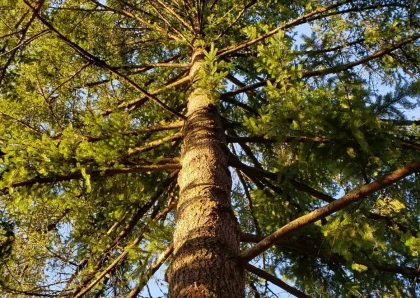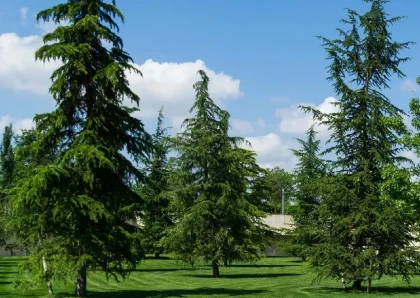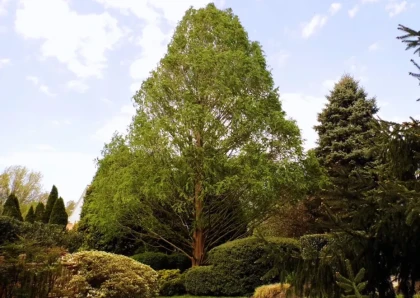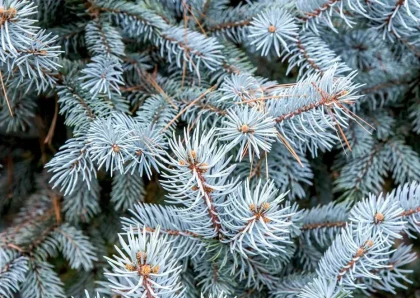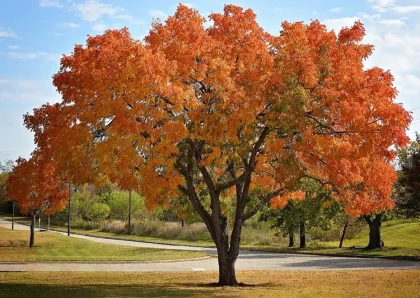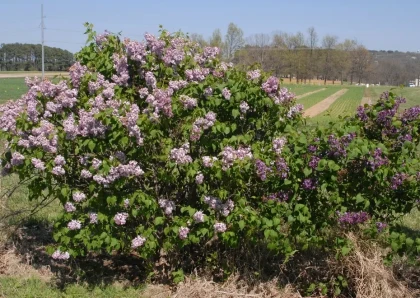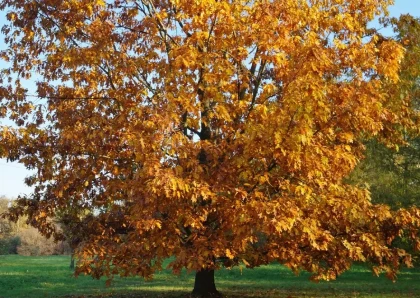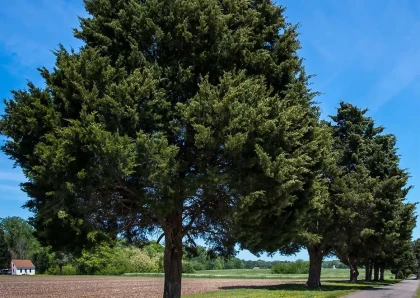
Golden Jubilee Peach Tree
Overview
Prunus persica 'Golden Jubilee' is a specific cultivar of peach tree. It is a deciduous fruit tree belonging to the Rosaceae family. 'Golden Jubilee' is known for its golden-yellow fruit, which is sweet and juicy, making it a popular choice among peach enthusiasts.
Key Features:
- Fruit: The fruit is medium to large-sized with a round shape. It has a golden-yellow skin with a sweet, flavorful, and juicy flesh.
- Harvest Time: 'Golden Jubilee' peaches typically ripen in mid to late summer, making it a delightful addition to the summer fruit harvest.
- Growth Habit: The tree has a moderate to vigorous growth habit, producing attractive pink flowers during the spring before setting fruit.
- Hardiness: 'Golden Jubilee' peach trees are generally hardy and can grow well in various climates, though they tend to thrive best in areas with a temperate climate and well-drained soil.
- Uses: The fruit can be enjoyed fresh, canned, or used in various culinary applications, such as desserts, jams, and preserves.
Types of Golden Jubilee
- Golden Jubilee Peach Tree: A specific cultivar of peach tree known for its golden-yellow fruit.
- Golden Jubilee Rose: A hybrid tea rose with large golden-yellow blooms and a strong fragrance.
- Golden Jubilee Medal: A commemorative medal or award given to celebrate 50 years of a significant event, reign, or service.
- Golden Jubilee of Queen Elizabeth II: The celebration of Queen Elizabeth II's 50th year on the throne, which occurred in 2002.
- Golden Jubilee Tomato: A tomato variety producing large, golden-orange, sweet, and flavorful fruits.
- Golden Jubilee of a Company or Institution: A celebration of a company or institution's 50th anniversary or 50 years of existence.
Products from Golden Jubilee Peach Tree
- Peaches: The delicious golden-yellow peaches can be enjoyed fresh, canned, or used in desserts, pies, jams, preserves, and various culinary applications.
- Wood: While not as commonly used as traditional hardwoods, the relatively soft peach wood can be utilized for smaller woodworking projects and crafts.
- Wood Chips: The pruned branches or wood from the peach tree can be chipped and used as mulch in the garden or for smoking meats.
- Infusions: The leaves or pits of peaches can be used to infuse flavor into products like tea or spirits.
- Natural Dyes: The bark or leaves of the peach tree can be used to extract natural dyes for coloring fabrics or other materials.
- Cosmetics: Peach extract or oil can be used as an ingredient in cosmetic products like lotions, soaps, and shampoos.
- Herbal Remedies: Some parts of the peach tree have been used in traditional medicine for potential health benefits, though caution should be exercised.
Benefits of Golden Jubilee Peach
- Rich in Nutrients: Peaches are a good source of essential nutrients like vitamins A and C, potassium, and fiber.
- Antioxidant Properties: Peaches contain antioxidants, such as vitamin C and various phenolic compounds, which help protect the body's cells from oxidative stress.
- Digestive Health: The fiber content in peaches can support healthy digestion and promote regular bowel movements.
- Immune System Support: The vitamin C in peaches contributes to a healthy immune system, helping the body fight off infections and illnesses.
- Skin Health: Vitamin C and antioxidants in peaches can support healthy skin and help combat skin aging caused by free radicals.
- Hydration: Peaches have high water content, making them a refreshing and hydrating fruit.
- Weight Management: Peaches are relatively low in calories and high in fiber, which can contribute to feelings of fullness and support weight management.
- Heart Health: Potassium in peaches may help regulate blood pressure and support heart health.
- Eye Health: The vitamin A in peaches is essential for eye health and vision.
Tips for Planting and Maintaining Golden Jubilee Peach
- Site Selection:
- Choose a location with full sun exposure (at least 6-8 hours of direct sunlight daily).
- Ensure the site has well-draining soil to prevent waterlogged roots.
- Avoid areas with poor air circulation or frost pockets.
- Soil Preparation:
- Peach trees prefer slightly acidic to neutral soil with a pH range of 6.0 to 7.0.
- Prepare the planting hole twice as wide as the root ball to promote root expansion.
- Incorporate organic matter like compost to improve soil structure and fertility.
- Planting:
- Plant the Golden Jubilee Peach tree in the spring after the last frost date in your area.
- Remove the tree from the container gently and place it in the planting hole at the same depth as it was in the nursery pot.
- Fill the hole with soil, pat it down gently, and water thoroughly to eliminate air pockets.
- Watering:
- Keep the young tree well-hydrated during its first growing season to promote root development.
- Water deeply and infrequently rather than frequent shallow watering.
- Adjust watering during rainy periods to prevent waterlogging.
- Mulching:
- Apply a 2-4 inch layer of organic mulch (wood chips or straw) around the base of the tree.
- Mulching helps retain soil moisture, suppress weeds, and protect the tree's roots from temperature extremes.
- Pruning:
- Prune the tree during the dormant season to remove dead, diseased, or crossing branches.
- Open up the canopy to improve air circulation and sunlight penetration.
- Training the tree to an open-center or vase shape is ideal for good fruit production.
- Fertilization:
- Fertilize the Golden Jubilee Peach tree in early spring before new growth begins.
- Use a balanced fertilizer or one with higher phosphorus content to encourage fruit development.
- Pest and Disease Management:
- Monitor the tree regularly for signs of pests or diseases like aphids, scale insects, or peach leaf curl.
- If needed, use appropriate organic or chemical control methods, following instructions carefully.
- Thinning Fruit:
- After the tree has set fruit, consider thinning excess fruit to encourage larger and healthier peaches.
- Thinning prevents overcrowding and helps the remaining fruit reach its full potential.
- Winter Protection:
- Protect young trees from harsh winter conditions by wrapping the trunk with tree wrap or burlap.
- Applying a layer of mulch around the base of the tree can also help protect the roots.
Cons of Planting Golden Jubilee Peach
- Climate and Frost Sensitivity: Peach trees, including Golden Jubilee Peach, are susceptible to frost damage. If you live in an area with late spring frosts, it may impact flower buds, leading to reduced fruit production or even no fruit at all.
- Disease Susceptibility: Peach trees are prone to certain diseases, such as peach leaf curl, bacterial spot, and brown rot. These diseases can affect the tree's overall health and fruit production if not adequately managed.
- Insect Pests: Peach trees can attract various insect pests, such as aphids, peach tree borers, and scale insects, which can damage leaves, fruit, and branches.
- Pruning and Maintenance: Peach trees require regular pruning and maintenance to promote proper fruiting, control size, and manage disease and pest issues. Neglecting pruning can lead to reduced fruit quality and an increase in disease and pest problems.
- Watering and Irrigation: Peach trees need consistent and adequate watering, especially during dry periods and the growing season. Improper watering can lead to stress, reduced fruit size, and susceptibility to diseases.
- Soil pH and Nutrient Requirements: Peaches prefer slightly acidic to neutral soil. Ensuring the correct pH and providing appropriate nutrients can be challenging in some soil types.
- Short Fruit Shelf Life: Fresh peaches have a relatively short shelf life and may require quick consumption or preservation if not used immediately.
- Space Requirement: Peach trees can grow relatively large, and it's essential to provide enough space for the tree to mature properly and have good air circulation.
- Wildlife Attraction: Ripe peaches can attract wildlife, such as birds and rodents, which may cause fruit damage.
- Fruit Drop and Thinning: Peach trees often experience fruit drop, where immature fruit falls prematurely. Proper fruit thinning may be necessary to improve fruit size and quality, which requires time and effort.
Conclusion
In conclusion, Golden Jubilee Peach, like other peach varieties, can be a delightful addition to your garden or orchard, providing delicious golden-yellow fruit during the summer harvest. Peaches, in general, are rich in essential nutrients, antioxidants, and fiber, offering several health benefits. Their sweet and juicy flavor makes them a popular choice for fresh consumption and various culinary applications, such as desserts, pies, jams, and preserves.
When planting and maintaining a Golden Jubilee Peach tree, it's crucial to consider factors like proper site selection, soil preparation, watering, pruning, and pest management. Ensuring the tree's health and vitality will lead to better fruit production and overall success in cultivating this fruit tree.
As with any fruit tree, regular care, attention, and monitoring for pests and diseases are essential to ensure the best performance of the tree. Proper maintenance practices, such as pruning and thinning, can also contribute to improved fruit quality and yield.
Before deciding to plant a Golden Jubilee Peach tree or any fruit tree, it's essential to weigh the pros and cons and dedicate time and effort to care for the tree properly. With the right care and attention, a Golden Jubilee Peach tree can reward you with a bountiful harvest of sweet and flavorful peaches for many years to come.
Frequently Asked Questions (FAQs)
Q1: What is Golden Jubilee Peach?
A1: Golden Jubilee Peach is a variety of peach tree (Prunus persica) known for its golden-yellow fruit and sweet flavor. It is a popular cultivar among peach enthusiasts.
Q2: When does Golden Jubilee Peach produce fruit?
A2: Golden Jubilee Peach typically produces fruit during the summer, with the exact timing depending on the local climate and growing conditions.
Q3: How do I plant Golden Jubilee Peach tree?
A3: To plant a Golden Jubilee Peach tree, choose a sunny location with well-draining soil. Dig a hole twice as wide as the root ball, place the tree at the same depth as it was in the nursery pot, and water thoroughly after planting.
Q4: What are the health benefits of Golden Jubilee Peaches?
A4: Like other peaches, Golden Jubilee Peaches are rich in essential nutrients, antioxidants, and fiber. They offer various health benefits, such as supporting the immune system, promoting skin health, and aiding digestion.
Q5: How do I care for a Golden Jubilee Peach tree?
A5: Proper care for a Golden Jubilee Peach tree includes regular watering, mulching, pruning during the dormant season, and pest management. Ensuring adequate sunlight and proper nutrition is also essential for its health.
Q6: Can I grow Golden Jubilee Peach in containers?
A6: While it is possible to grow a Golden Jubilee Peach tree in a large container, it is not the ideal growing environment for long-term success. Peach trees prefer the ground for proper root expansion and better stability.
Q7: Is Golden Jubilee Peach self-pollinating?
A7: No, Golden Jubilee Peach is not self-pollinating. It requires cross-pollination with another peach variety for optimal fruit set. Planting different peach varieties nearby can help with pollination.
Q8: How long does it take for Golden Jubilee Peach to bear fruit?
A8: Golden Jubilee Peach trees usually start bearing fruit after about 2 to 4 years of planting, depending on the age and size of the tree at the time of planting.






